Sub-classifications according to purpose and integrated testing are required to keep an industrial occupancy fire-safe
In February, 300 firefighters responded to a blaze at a warehouse for online grocer Ocado in Andover, England. The 240,000 sq. ft. facility housed an automated distribution center that utilized 1,100 swarm robots – waist-high units moving along a three-story aluminum grid system at thirteen feet per second which assemble, package, and send online grocery orders. The robot system in the facility was capable of handling more than 4,000 orders per day and accounted for 10% of Ocado’s food deliveries. The cause of the fire remains under investigation, but the $58 million facility is a total loss and the company has seen its share price drop more than 6%.
In June of 2018, the Ocado warehouse had received the Highly Protected Risk (HPR) designation from FM Global. This designation indicates that a “facility meets the highest industry standards for property protection” and should have experienced fewer losses and lower cash flow volatility. These factors give any organization with the HPR seal of approval the leverage to command the best insurance coverages and terms.
So, how can a loss like this occur in a building boasting an HPR designation and equipped with fire sprinklers and fire alarms?
These questions have yet to be answered. However, current model fire codes produced by the National Fire Protection Association (NFPA), and the International Code Council (ICC) provide detailed guidance and requirements for the protection of industrial facilities.
Given the total loss of the Ocado warehouse, it seems reasonable to speculate that one or more of these elements was missing or not functioning properly.
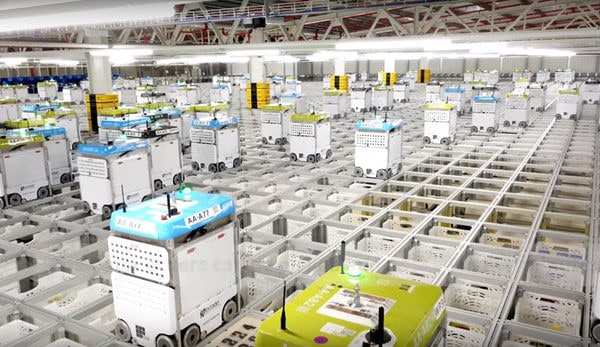
What is an “industrial” occupancy?
NFPA 101: Life Safety Code defines industrial occupancies by their purpose:
From the 2018 edition of NFPA 101
40.1.1.4 Industrial occupancies shall include factories making products of all kinds and properties used for operations such as processing, assembling, mixing, packaging, finishing or decorating, repairing, and similar operations.
The International Fire Code (IFC), published by ICC, classifies industrial facilities as “Group F” occupancies. These are “factory industrial” facilities that engage in manufacturing, packaging, or processing operations.
From the 2015 edition of the IFC
[BG] Factory Industrial Group F. Factory Industrial Group F occupancy includes, among others, the use of a building or structure, or a portion thereof, for assembling, disassembling, fabricating, finishing, manufacturing, packaging, repair or processing operations that are not classified as a Group H high-hazard or Group S storage occupancy.
NFPA and IFC also require sub-classification of industrial occupancies
To determine the required level of fire protection, an “industrial occupancy” must further be classified as a general industrial, special-purpose industrial, or high-hazard industrial facility. The NFPA bases these sub-classifications on the hazard of operations – low, ordinary, or high – and the nature of the structure itself.
From the 2018 edition of NFPA 101
6.2.2.2* Low Hazard Contents. Low hazard contents shall be classified as those of such low combustibility that no self propagating fire therein can occur.
6.2.2.3* Ordinary Hazard Contents. Ordinary hazard contents shall be classified as those that are likely to burn with moderate rapidity or to give off a considerable volume of smoke.
6.2.2.4* High Hazard Contents. High hazard contents shall be classified as those that are likely to burn with extreme rapidity or from which explosions are likely.
General industrial facilities are those that engage in low and ordinary hazard operations, and the building itself is of a conventional design which could be occupied by various types of tenants and processes.
Special-purpose facilities are those that engage in low and ordinary hazard operations, but within a structure custom-built for a specific operation or function. Special-purpose facilities are often characterized by a low number of employees and personnel, with a lot of space being taken up by machinery and equipment.
High-hazard facilities are simply those that use, process, store, or handle contents that are likely to burn quickly and/or explode. Facilities that utilize any type of chemical in excess of the maximum allowable quantities (MAQ) defined by the fire code are also classified as high-hazard. The MAQ is the maximum amount of hazardous materials that may be stored, used, or dispensed within a single control area. Allowable quantities and the process for determining the MAQ are outlined in chapter 60 of NFPA 1: Fire Code.
The IFC divides its Group F occupancies into F-1, F-2, or Group H. These designations are based on the hazard and combustibility of products being used within the facility. Industrial facilities and operations that utilize only noncombustible materials and do not involve a “significant fire hazard” are classified as F-2 – low-hazard occupancy.
Other industrial facilities that do not meet these requirements are classified as an F-1, moderate-hazard occupancy or – similar to the NFPA designation – Group H high-hazard occupancy. Group H includes facilities or operations that require the use, processing, and storage of hazardous chemicals in excess of the maximum allowable quantities.
Determining the industrial facility sub-classification must be done correctly, as this will determine when a fire sprinkler and a fire alarm system will be required.
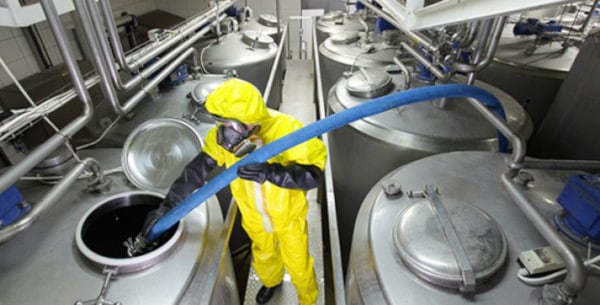
When are fire sprinklers required in industrial occupancies?
The Life Safety Code requires an automatic extinguishing system in all industrial occupancies that are classified as high-hazard and areas that pose an explosion risk.
From the 2018 edition of NFPA 101
40.3.2.1 All high hazard industrial occupancies, operations, or processes shall have approved, supervised automatic extinguishing systems in accordance with Section 9.7 or other protection appropriate to the particular hazard, such as explosion venting or suppression.
The International Fire Code requires an automatic sprinkler system in all Group H, high-hazard occupancies, and in F-1, moderate-hazard occupancies that meet the requirements listed in section 903.2.4:
From the 2015 edition of IFC
903.2.4 Group F-1. An automatic sprinkler system shall be provided throughout all buildings containing a Group F-1 occupancy where one of the following conditions exists:
1. A Group F-1 fire area exceeds 12,000 square feet.
2. A Group F-1 fire area is located more than three stories above grade plane.
3. The combined area of all Group F-1 fire areas on all floors, including any mezzanines, exceeds 24,000 square feet.
4. A Group F-1 occupancy used for the manufacture of upholstered furniture or mattresses exceeds 2,500 square feet.
Various codes and standards will use the term “fire area” to describe a protected area. This should not be confused with the building’s total square footage.
From the 2015 edition of IFC
[BF] FIRE AREA. The aggregate floor area enclosed and bounded by fire walls, fire barriers, exterior walls or horizontal assemblies of a building. Areas of the building not provided with surrounding walls shall be included in the fire area if such areas are included within the horizontal projection of the roof or floor next above.
When are fire alarms required in industrial occupancies?
The Life Safety Code requires that a fire alarm system be installed within industrial occupancies that exceed a total occupant load of 100 and when there are more than 25 people located above or below the level of exit discharge.
Occupant loads are determined by dividing the available floor area square footage by the occupant load factors shown in Table 7.3.1.2 of NFPA 101:
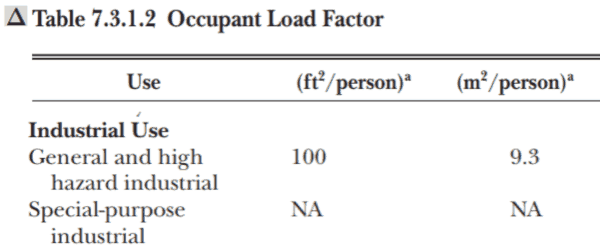
To determine the occupant load, you measure the square footage of a given area and divide it by the allowed square feet per person. For example, a 2,000-square-foot building would have an occupant load of 20 people, given the maximum of 100 square feet per person listed in the table above. There is no occupant load for special-purpose buildings; this is described in the definition of these structures, as these are custom built with the intention of the lowest occupancy needed.
The International Fire Code requires the installation of a fire alarm system when the Group F facility is two or more stories in height, or when the total occupant load exceeds 500 above or below the lowest level of exit discharge.
From the 2015 edition of IFC
[BE] EXIT DISCHARGE. That portion of a means of egress system between the termination of an exit and a public way.
[BE] EXIT DISCHARGE, LEVEL OF. The story at the point at which an exit terminates and an exit discharge begins.
Fire alarm systems are also required in those Group H occupancies that include semiconductor fabrication or comparable processes, and in those high-hazard occupancies that manufacture organic coatings. In Group H facilities that involve materials or processes that utilize highly toxic gases, organic peroxides, and other oxidizers, these minimally require an automatic smoke detection system (as opposed to a full fire alarm system).
Industrial occupancy fire protection systems require integrated testing
Reports from firefighters responding to the Ocado warehouse fire indicate that their extinguishment efforts were hindered by the packaging robots. The firefighters stated that the robots were still active and moving along their tracks. These claims have been refuted by the Ocado warehouse management, however. They insist that their system is designed to shut down all robot activity upon activation of the fire alarm system.
Integrated testing, introduced in the 2018 edition of the Life Safety Code, is required to ensure that these functions take place during a system activation. Integrated testing is required in industrial occupancies.
From the 2018 edition of NFPA 101
40.7.4.1 Integrated fire protection and life safety systems shall be tested in accordance with 9.11.4.1.
Integrated fire systems are those fire protection and life safety systems that “are required to operate together as a whole to achieve overall fire protection and life safety objectives.” (NFPA 4)
An example of an integrated system might include a fire alarm, fire sprinkler, elevator recall, and smoke control. When a fire is detected, each of these items has a specific code-required function to perform. Integrated testing ensures that these systems all work together flawlessly.
From the 2018 edition of NFPA 101
9.11.4.1. Basic Testing. Where required by Chapters 11 through 43, installations involving two or more integrated fire protection or life safety systems shall be tested to verify the proper operation and function of such systems in accordance with 9.11.4.1.1 and 9.11.4.1.2.
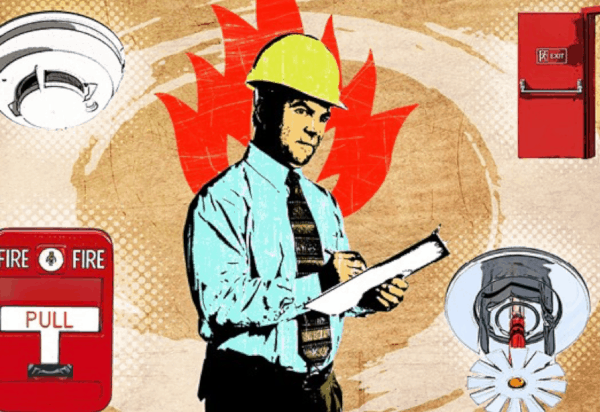
Effective fire protection of a facility, especially specialized structures such as industrial occupancies, relies on a combination of systems working in unison. Just the presence of a fire sprinkler or a fire alarm will not protect the facility.
The Ocado warehouse fire demonstrates the increasing fire protection challenges of high pile and rack storage, limited access, and robotics and electronic automation systems. As constantly evolving technologies result in more complex industrial and warehousing facilities and operations, the selection, installation, and integration of fire protection products becomes more critical than ever.
QRFS provides products that can meet many fire protection challenges solved by automatic sprinkler systems. We are here to serve your industrial fire protection needs with our selection of specialty tools, valves, sprinkler heads, and alarm components.
If you have questions or you need help finding an item, give us a call at 888.361.6662 or email support@qrfs.com.


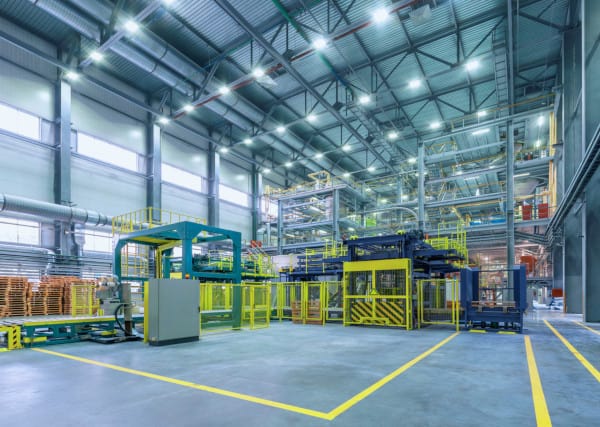
Is sprinkler system required for special purposes industrial non-occupied occupancies?
Mohamed, thanks for reaching out. To determine the required level of fire protection, an “industrial occupancy” must further be classified as a general industrial, special-purpose industrial, or high-hazard industrial facility. Ultimately, you need to connect with the authority having jurisdiction—be it a government official or insurance professional—to determine the hazard of operations and assess if a sprinkler system is required.
The NFPA bases industrial occupancy sub-classifications on the hazard of operations – low, ordinary, or high – and the nature of the structure itself.
From the 2018 edition of NFPA 101
6.2.2.2* Low Hazard Contents. Low hazard contents shall be classified as those of such low combustibility that no self propagating fire therein can occur.
6.2.2.3* Ordinary Hazard Contents. Ordinary hazard contents shall be classified as those that are likely to burn with moderate rapidity or to give off a considerable volume of smoke.
6.2.2.4* High Hazard Contents. High hazard contents shall be classified as those that are likely to burn with extreme rapidity or from which explosions are likely.